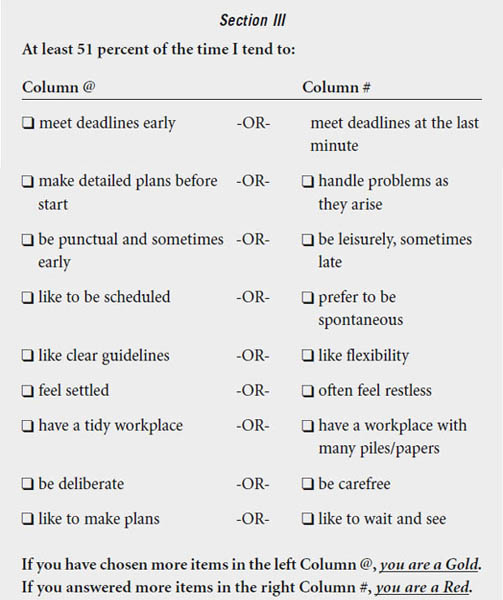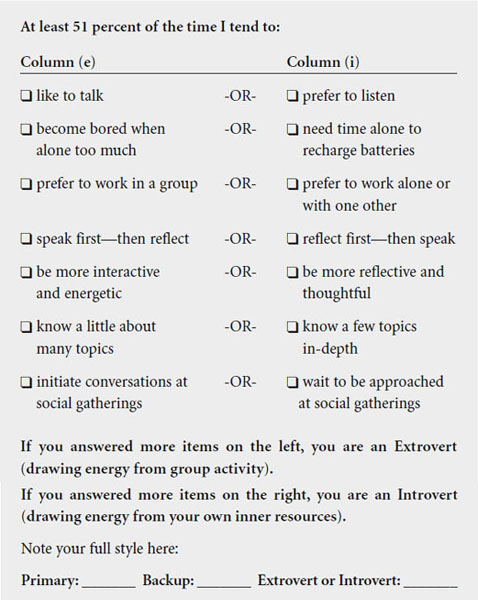
THE DUAL EPIDEMICS of workplace conflict and employee disengagement have reached alarming levels and need to be addressed immediately. Modern Survey, a human capital measurement firm, reported a record-breaking 70 percent level of U.S. employee disengagement in 2011. CPP, a provider of products and services for individual and organizational development (including the Myers-Briggs Type Indicator), compiled a 2008 “Human Capital Report” of 5,000 workers in nine countries. The results revealed U.S. employees spend 2.8 hours a week dealing with conflict, which equals a staggering $359 billion in paid hours per year.
This book is a tool to reverse these numbers.
The theory behind the Color Q system has been tested for decades on millions of people worldwide. For many individuals, including both authors of this book, the system has been career and life changing. The following self-assessment test is your key to this very powerful (and actually rather fun) professional and personal tool.
There are four parts to the Color Q assessment and one supplemental section. Together, they will take you about ten minutes to complete. Part I will test you for your Color Q primary personality color. This is who you are at your core, when no one’s looking.
Note: In the self-assessment you will be asked to select your preferences. A preference is not “I generally work with piles, but I’d prefer if I kept my desk clean.” What you generally choose to do is what you prefer. Slight or strong, there is always a preference.
Part I has three sections. To begin, select one of the two choices in each line according to your first impulse, which is usually correct. There are no “right” or “wrong” answers, just like being right-handed or left-handed is neither right nor wrong. While you can use both, you use the preferred hand with less effort and better results. If you are truly torn between the two choices, it typically means you feel pressured to function in a certain way. Right now, set the guilt and pressure aside.
Choose your answer from either Column A or Column B. Each choice must be filled in, choosing the statement that describes you at least 51 percent of the time. You should wind up with a total of nine checkmarks in each of the sections (I, II, and III).
For example, the first set of choices reads: At least 51 percent of the time I tend to:

Which do you prefer most of the time? Accuracy or insights? Put a checkmark in the box next to “accuracy” or “insights” and move on to the second set of choices below it. You may not check off both boxes; check only the box where you have a slight or strong preference.

Now read the short overview of your primary color. Does it ring true? If yes, continue to Part III to determine your backup style. If not, skip down to the section on “What to Do If This Doesn’t Ring True for You.”
Grounded, realistic, and accountable, Golds are the backbone of institutions of all kinds—corporate and public. They are society’s protectors and administrators who value procedures, respect the chain of command, and have finely tuned systems for everything. From raising children to running large divisions, Golds get involved in details and are known for following through and mobilizing others to achieve concrete goals. They are most interested in making lists, planning in advance, and dealing with what has worked in the past.
Theoretical, competitive, and always driven to acquire more knowledge and competence, Blues are unequaled when it comes to dealing with complex, theoretical issues and designing new systems. As natural skeptics, their first reaction is to criticize and set their benchmarks against which they measure everyone and everything. They are highly precise in thought and language, trusting only logic, not the rules or procedures of the past. Blues are future-oriented visionaries who do best in positions requiring strategic thinking. Then they move on with little interest in maintenance.
Action-oriented, spontaneous, and focused on “now,” Reds need freedom to follow their impulses, which they trust over the judgment of others. Cool-headed and ever courageous, they get things done and handle a crisis better than most. Found in careers that provide freedom, action, variety, and the unexpected, they bring excitement and a sense of expediency. Work must be fun and the environment collegial. Reds resist schedules and hierarchies. Long-term planning is a low priority as each day brings its own agenda.
Creative, empathetic, and humanistic, Greens need an environment that is idea-oriented and egalitarian and that provides the chance to impact the lives of others. Gifted in their understanding of people’s motivations, they have an unusual ability to influence and draw the best out of others. They also excel in verbal and written communications and in the ability to position ideas. Greens are enthusiastic spokespersons for the organizations of their choice, and have a unique, charismatic quality that sweeps others into their causes.
Now that you have determined your primary style, go back to the assessment and fill out the section you originally left out (that is, Section II or Section III). This exercise will provide you with your backup style. You should share about 40 percent to 50 percent of the characteristics of your backup style. The backup style refines your primary style.
If your primary is Gold or Red, your backup would be either Blue or Green.
If your primary is Blue or Green, your backup would be either Gold or Red.
My primary style is _______________. My backup style is _______________.
From each pair of statements, choose one statement from the left or right column. You should wind up with seven checkmarks in this section.

The Extrovert/Introvert dimension is often misunderstood. That’s because it appears to be a biologically based preference for recharging one’s batteries. It has nothing to do with being socially adept—there are Introverts with wonderful people skills and Extroverts who turn people off.
Extroverts (which the Myers-Briggs community spells as “extraverts”) get their energy from being with people and doing group activities. If they have to spend too much time alone or doing tasks in solitude, they become tired, bored, and dispirited. Conversely, Introverts get energized from spending time alone to recharge their internal batteries. Even if they like being with people, which most Introverts do, too much interaction drains their energy.
The population divides fairly equally between Extroverts and Introverts, and many people hide their natural preference well. An Introvert who needs to socialize for business can appear Extroverted. Also, as your score will indicate, you may be mild or pronounced in this dimension. Relationships between Introverts and Extroverts are often tense, until this dimension is understood and valued.
Familiarize yourself with all the Color Q personalities, then focus on you: Greens are covered in Chapter 5, Reds in Chapter 10, Blues in Chapter 15, and Golds in Chapter 20. Go next to your individual chapter, which is one of the four chapters after your primary color.
Your Color Q personality is simply who you really are when you are not being pressured by family, friends, or work/life demands. But if the majority of characteristics do not ring true, it’s likely you belong to another group.
Reexamine the section of the self-assessment where you had close scores. Did you answer as other people need you to be? Or as you feel you ought (instead of prefer) to be? That creates false results. Choose the opposite column choice and follow instructions to a new color. If that fits better, return to Section III and continue.
Or see if a family member or friend who knows you well agrees with your self-assessment. You might be surprised, as one lawyer was when her friend of thirty years completely corrected her answers! The lawyer didn’t want to admit to her real preferences for piles on her desk and last-minute deadline rushes. Remember, no one is judging you or suggesting that you need to change. What you categorize as a “weakness” is probably a strength—the lawyer was effective and innovative under chaotic circumstances.
If you currently are going through catastrophic life changes, or have been dissatisfied with your life for some time, scores may reflect your survival skills and not your real preferences. You may have “forgotten” your real preferences (unhappiness is a signal they’re being denied). Try answering as if, right now, you lived in the world of your choice. If your personality color still seems wrong, wait until things have stabilized and retest yourself.